A few weeks, back, I spent about half an hour chatting with Jeremy, KF7IJZ, for a listener-projects segment on the HamRadio360 Workbench podcast. That episode just went live this morning, if you want to take a listen online. Jeremy and I had a swell time chatting about the QST 40-9er Transceiver project I built awhile back, and ended up packaging with a laser-cut faceplate.
Seeing the podcast pop up got me thinking – from the last few months of posts, you’d think that I’d been spending all my time operating and that my bench was empty. Not so! There are three major projects milling about the bench these days. None are complete enough to merit a full post, but consolidating them all in to one post feels right.
First on the bench is the continuation of my Beach 40 Transceiver project, that I’ve been working on since the Fall. I’ve been making steady progress recently on the penultimate stage, the RF amplifier, which will take the ~10dBm modulated voice signal from the balanced modulator and turn it into ~33dBm (2W) of RF output power to send to the LPF and out into the world. The amplifier is a three-stage design, with a 2n3904 buffer feeding a BD139 driver and another BD139 final.

The module is assembled manhattan-style on single-sided copper glad, just like the rest of the project. The layout surrounds the +12V-on-transmit bus down the center of the PCB… more on that error later.
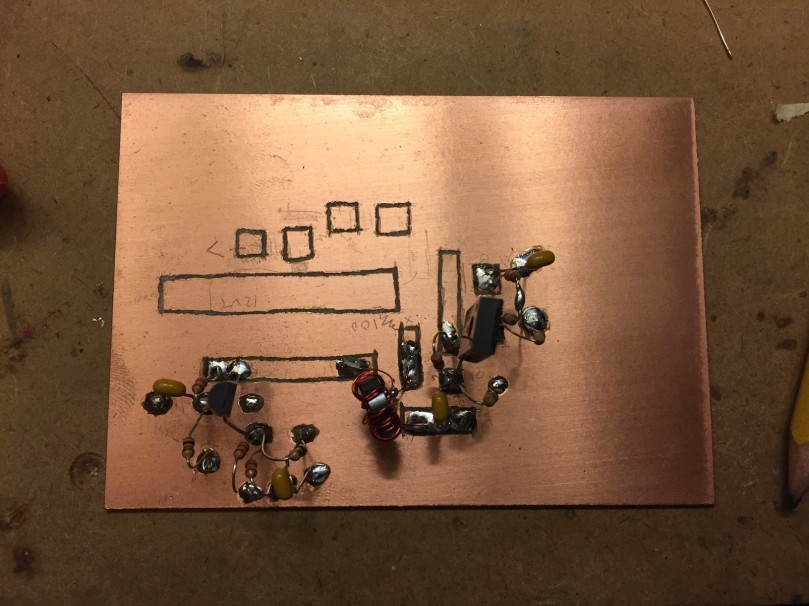
The module assembly and testing went fairly smoothly – using a variable-voltage power supply, it’s easy to vary the output power of the amplifier, and to observe the changes in PA heating that this causes. You can see the two large screw-on heat sinks on the BD139’s in the following pictures, as well as the the large ferrite bead which feeds the Final. There’s also a chunky 100uF cap at the DC input to the board for additional decoupling.
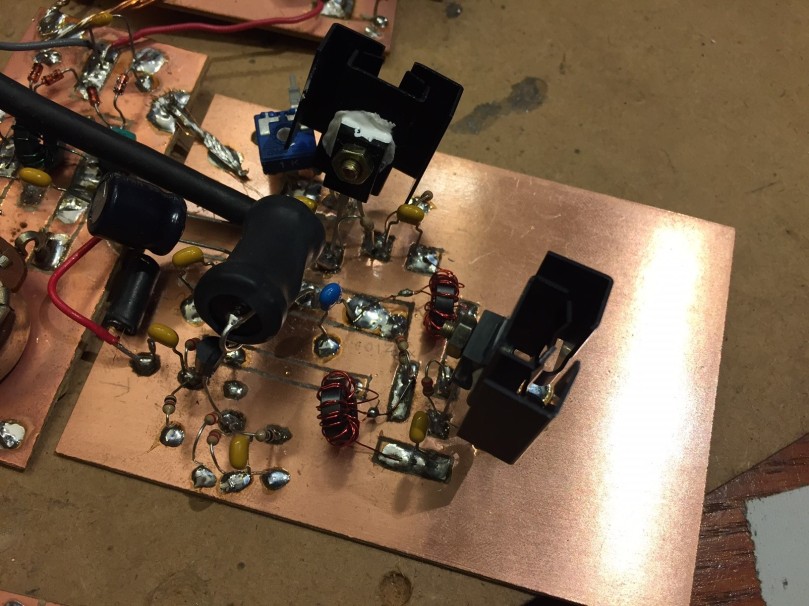
The problem I’m having now is the same one that plagued me way back in my assembly of the Virgin Receiver, my first first homebrew receiver: this amplifier would really love to be an oscillator. With the PA voltage set at 12V, any time the signal imput is sufficiently strong, the PA will fall hard into oscillation, and won’t stop until the PA voltage is brought way down or cut. I’ve been experimenting with emitter degeneration for the final BD139 (the original schematic has the emitter directly grounded). That’s helped, but not much. I’ve also changed the RF-carrying wires from hookup wire to coax, to mitigate feedback through other modules. Another help, but so far, the oscillation problem is still there. The next step will be to move the modules themselves around, to limit the amount that the high-power RF coming from the PA has to pass by earlier stages of the transmit chain (VFO, mic amp, balanced modulator) to try to eliminate feedback that way. Fingers crossed!
Next on the bench is a repackaging of an old project – my SI5351-based “VFO,” which for the better part of a year has been serving as my primary signal generator for experimental projects, spread out in all its Al-Fresco glory on a breadboard. With the amount of troubleshooting I’ve been going through on the Beach 40 project, I’ve decided to finally box up the SI5351, Arduino, and display into a proper project box, and make the thing a real SI5351-based Signal Generator. The schematic is essentially unchanged (minus the PA) since I used the project in my SI5351-based transmitter project, which is reproduced below:
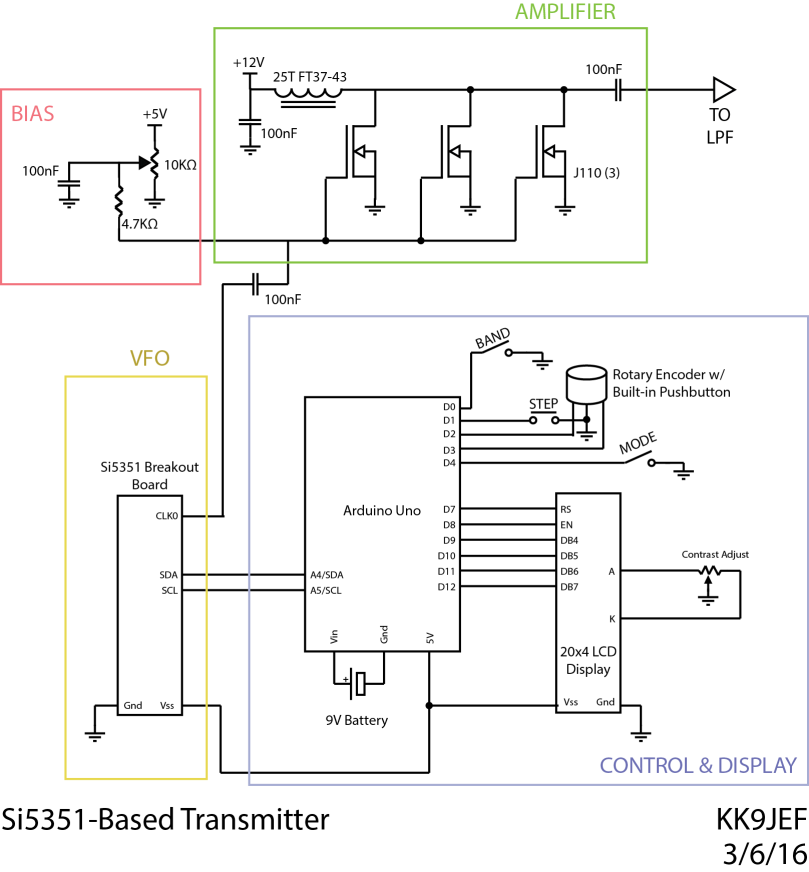
To that end, I purchased an inexpensive nibbling tool and an expensive project box from the local Fry’s electronics, and have been working in the past couple weeks to marry the spread-out guts of the previous project with the clean lines of the enclosure. Biting out the large hole for the display 1/8″ at a time was time-consuming and strangely soothing.
At this point, the display and Arduino are connected, but I have yet to wire the two control buttons, rotary encoder, and Si5351 breakout board back into the Arduino. I also need a provision for getting the signal out the front of the darn thing, so I’m waiting on a shipment of SMA connectors and a jumper to go from the SI5351 breakout board to the front panel. So far, so good.
The code for this project is still on Github.
The last project on the bench is an RF power meter circuit, based on a circuit by W7ZOI from 2001. While the old scope-probe-across-a-50-ohm-load technique has proven very useful, I’ve found myself wanting a way to more reliably measure RF power at low levels, and to do it in a way that could be interfaced to a microcontroller or computer. To that end, I plan on using the W7ZOI circuit connected to an Arduino, much like Vu2ESE’s Sweeperino, to make digital power measurements.
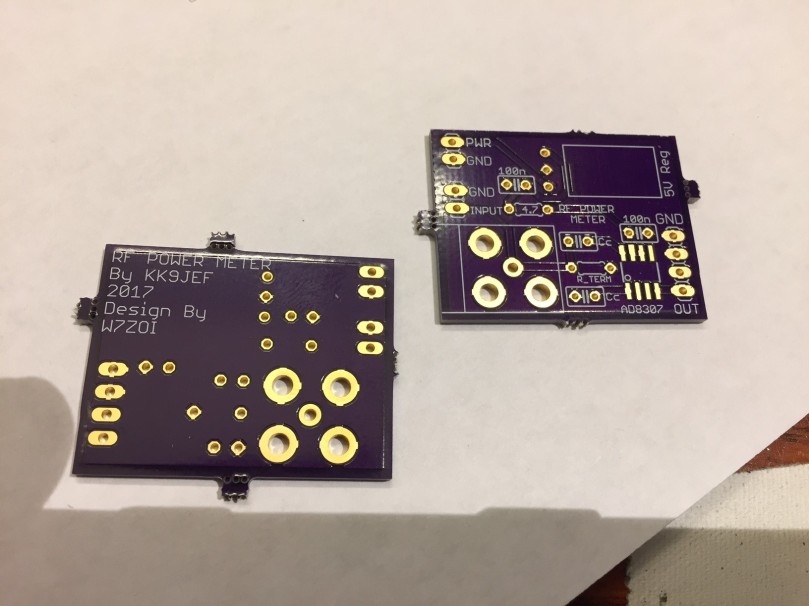
I rolled a little PCB for this project from OSHPark, and since that service provides PCBs in multiples of 3, I figure I’ll connect one board to an analog meter (for that old-school feel), one to an independent Arduino (for digital measurements), and embed one inside the SigGen project, for marrying signal generator and power measurement at specific frequencies. This last project, I figure, will be especially useful for examining filter behavior at HF and piping the information to a PC for display an analysis.
So that’s what’s on the bench at the end of March 2017. All of these will hopefully merit full posts in future as the projects come to fruition, but for now, the is the smorgasbord that is my bench.
Hear you on the air!
73
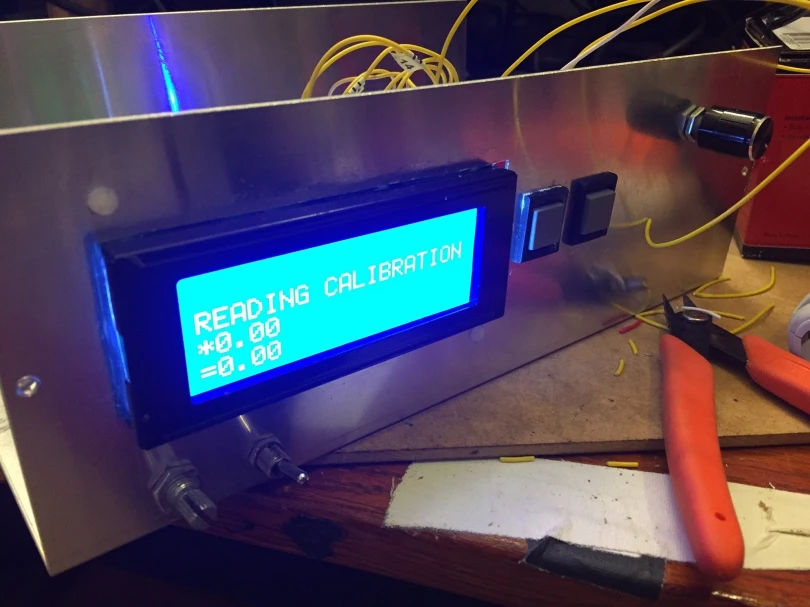




Nice documentation as usual. Having also made Vu2ESE’s Sweeperino, digital power measurements are easily accomplished. Very handy piece of test gear.
LikeLike
[…] I populated and installed one of the AD8307-based power meter PCB’s that I cooked up back in March, fed directly from the external SMA connector. The output feeds the mA meter through an op-amp […]
LikeLike
Hi kk9jef!
Guess have the same thing with Beach 40 power amp to osccilate when I changed the simple wire from mixer too the amp to coax with low losses. Becouse, before that the total power output was 0.5w with disbalanced mixer and the carrier can be supressed with trim pot. But not with coax. It just gives 1W no matter how the ballance is set now. Gotta try to bring back the wire back and take a look.
https://wordpress.com/read/feeds/70127443/posts/1561260924
LikeLike
Love your documentation on your projects!
Just wondering how it’s going with the Beach 40. I had issues with a loud “chirp” after transmit that would somehow sometimes end up with oscillations within the audio amplifier.
What I found was that it seemed to be the charging/de-charging of the caps that cause that sound in the LM386.
My workaround was to leave both mic preamp and audio amp powered, and use a second relay to switch the connection to the ring mixer between the mic and the audio amp. This takes out the big “click” as well.
Now, I have a close AM station that’s killing the receive, so I need to get that fixed.
Hope that helps some!
73
W4XXV
LikeLike